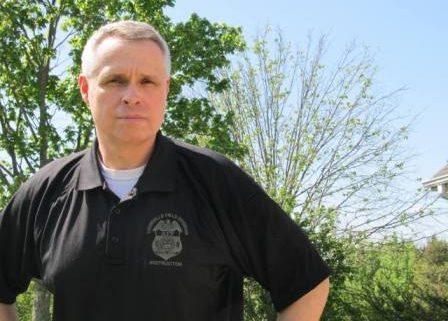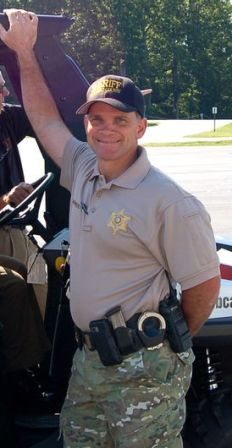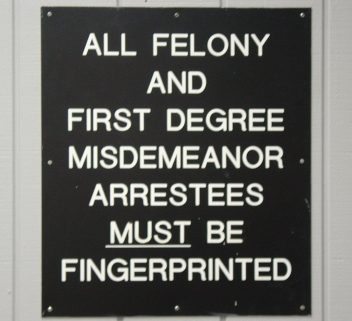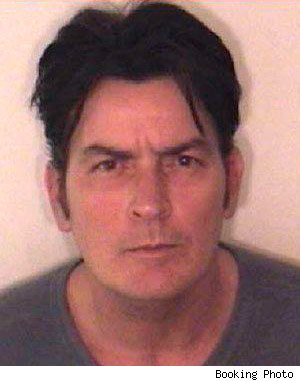As anyone who has attended a Writers’ Police Academy (WPA) can attest to there’s so much to do and take in that is a sensory overload. The days start early and end late at night, much later if you linger at the bar, and by the time Lee announces the end on Sunday morning, most everyone is mentally overloaded and physically exhausted. But it’s a blast. Every year when it’s over, I have had a great time and have a wealth of new memories. So as time grows closer for WPA, I find myself reflecting on previous years’ events and wondering how the upcoming Writers’ Police Academy will compare.
Since I have been lucky enough to be part of every WPA to date, I thought I’d come up with my own Top10 Memories of Lee Lofland’s Writers’ Police Academy (in no ranking order).
10. Lee’s Vision.
I first met Lee way before WPA was around…you could say the idea was a mere twinkle in his eye. Lee and I had crossed paths at conferences before, but the first time he mentioned his idea for what became Writers’ Police Academy was when we both were speaking at Forensics University sponsored by Sisters in Crime in St. Louis. We got to the hotel early and bumped into each other at the check-in desk. Lee invited me to lunch and we talked well after our meal was done. We had talked about all kinds of things, and then Lee asked me, “You know what I think would make a great conference? Something that’s not been done, and I’d like to do?”
I told him no.
“I want to organize a writers’ conference just about law enforcement and first responders for writers. I want this conference to be more than presentations. I want the attendees to get a real hands-on learning experience like at a real police academy.”
I told Lee I thought it was a great idea. What I didn’t tell him were my doubts that it would work because–a) I didn’t think any police academy administrator would agree to let civilian outsiders into their facility and b) it sounded like a heck of a lot of moving parts and a lot of work to make it all come together. So when he asked if I’d be interested, I told him I would, but I really didn’t think it would happen. Yet as I’m typing this, he’s about to launch the fifth WPA. Lee’s vision surely has surpassed what I had thought when he first told me about his idea for a “unique conference.” Lee calls WPA a Disneyland for writers, and listening to the attendees talk, I think that’s an accurate description.
One of the most popular events at WPA (if you can get a slot) is the for attendees to participate in the FATS/MEGGETTS interactive shooting simulator. My next couple of WPA Top 10 come from my own experiences in the FATS room.
9. Shooting with Jeff Deaver.
At the first WPA, Lee asked if I would shoot FATS with Jeff Deaver (I’m old school, so all firearms video training systems are still FATS to me). The Jeff Deaver? I asked. Yup, Lee said. Sure thing—who wouldn’t want the chance to do gun scenarios with the devious mind and quick trigger finger of Jeffrey Deaver? I had fun, and so did Jeff if his smile was any indication. Of course he was rocking-and-rolling full auto with the M4 in each scenario. We all had fun.
8. Christmas Story!
The second year, the FATS room was short an instructor, and they asked if I’d sit in and help as a safety officer for the day. Most of the time, all I was doing was making sure the students understood how to grip the pistol and to keep their fingers away from any moving parts. And those of you who have shot FATS/MEGGETS know the pistols actually cycle like a real gun. I kept making sure the shooters kept their support thumb away from the back of the gun so that they wouldn’t get a nasty “bite” when the pistol’s slide cycles.
I didn’t know I had to worry about other body parts!
Things went smooth most of the day until after lunch we had three ladies running through some scenarios. They had already run through one scenario and I thought things were going smooth, so as Jerry Cooper started the next one, I did my safety check and stepped back to watch scenario and the shooters. Things went from normal to “the fertilizer hitting the vertical oscillating device” super quick in the scenario with a badguy shooting shortly after they screen started rolling. Things seemed to roll along with several of the students even shouting police as they shot back. On the screen, the badguy was pumping out rounds, bystanders were screaming and the students rounds were hitting. Total controlled mayhem.
Then I heard a voice just to my left shout—“I shot my eye out!”
I have to admit my first thought was that great movie a Christmas Story, and I was sure Ralphie and his Red Ryder were in the room.
My second thought was to get to the student and see what was going on. Taking the gun from the lady’s shaking hand, I asked what had happened.
“I think I shot my eye out,” she repeated.
Looking at the pistol and her face I didn’t see any blood. I did see a small scratch on her glasses. But nothing else. Once we got it all sorted out, I learned that the lady thought she could see the sights of the gun better if she put the gun up closer to her face. I mean like THIS close. Right at the edge of her nose close. You guessed it. When she fired, the slide cycled back and hit her glasses, shoving them up her nose. Thankfully no injuries. And even after the scare, our student, ever the Trooper, stepped right back up and went back to blasting badguys.
Still—“I shot my eye out.”
Donations for the silent auction and raffle. A few years ago, Lee was talking about how much work he had to do with WPA and hadn’t had time to start getting donations, so I offered to help out there. Now, it’s sort of a routine, that somewhere in the spring we’ll email and Lee will let me know—it’s time again. Then I’ll sit down and start emailing authors asking for them to donations. Some I may know and have met, but a great many I email through their website, and more often than not, we get a response. Doing the emails is a little time consuming, but you get to hear from a lot of people. And see how good the writing community truly is. The next couple of WPA Top 10 is about the silent auction and raffle.
7. Generosity.
Many people have never heard of WPA until my unsolicited email pops in their inbox. What’s heartwarming is that usually they email back saying how that the conference looks awesome and offering to help. Many of those same people send donations every year too. We’ve had authors donate signed books, t-shirts, character naming and even critiques all to support WPA’s silent auction and raffle. The people who donate are generous and have big of hearts.
6. Joseph Wambaugh.
I have to single out Mr. Wambaugh, the father of modern police procedures for a slot on my Top 10. One year, I started early on a Sunday morning with coffee at hand and a list of authors and started firing away emails for WPA. I had just finished sending out the first batch of emails, so I wasn’t very far into it, when my email dinged. My new email was from Joseph Wambaugh himself. Not an auto-reply. Not an assistant. But Joseph Wambaugh himself answered an email to his website at about 6am West Coast time. His email was short. He wished WPA success and offered to send an autographed book. Classy. A classic memory.
Of course there’re so many memories from the actual conference:
5. Fan moments.
Most people have “fan moments” at conferences, but I remember a really cool one the year Lee Child was guest of honor.
After the banquet, people drifted to the bar. A couple of WPA students were already at the bar. Also at the bar was a guy with a beer and an e-reader, but it was obvious he wasn’t part of WPA. One of the WPA students asked him what he was reading. He said the latest book by his favorite author Lee Child. One of the people told him that Child was at Writers’ Police Academy and would probably be at the bar. You could tell the guy thought they pulling his leg. One of the WPA students went and told Lee Child, and a few minutes later, he wandered into the bar and sat down and talked to this guy for a few minutes. He signed the guy’s ereader. And the guy was tickled to death.
4. Code-names.
It seems that cops are not the only ones who have their own lingo, jargon, slang and code words. It seems that a few of WPA’s attendees (YOU guilty parties know who you are) came up with some personal nicknames for some of the WPA instructors. There were– (RANK) Hot Pants and (RANK) Honeybuns.
The ranks of the parties have been withheld less they be identified.
But, no pun intended, those of you have been to previous WPA, you know what those code-names mean AND who they’re about. I’m sure more code names will be forthcoming.
3. The weather.
Lee always tells you that North Carolina in September is usually hot, but can get rainy. Most of the time, we’ve had wonderful weather for the equipment and vehicle demonstrations and display….but. The first year Bill Lanning orchestrated a shallow grave complete with body and accompanying smells, it rained. It did not just rain. It poured buckets. Nonstop. However, the ghoulish WPA students didn’t let the weather deter them from trekking out to see and smell the shallow grave. Even though they were water-logged, the shallow grave demonstration was a hit.
2. Surprises. Surprise, surprise, surprise.
Each year, Lee and his Minions come up with tons of surprises. Now, it’s probably getting harder and harder for Lee and his mischievous makers to pull off the surprise, but they’ve done it every year. What kind of surprises? Students standing around waiting to hear a briefing when gunfire erupted in the GTCC building followed by screams. An active shooter. The cops and first responders arrived—and WPA students had front row seats. Next year was the squealing tires and sirens of the car chase followed by a tense standoff and shootout. How about Stan taking Sandra hostage in the auditorium until a well placed shot by Codename Honeybuns ended the standoff. Then last year was the bomb squad and a suspicious package which had to be blown up on the tarmac while the students all watched. What’s in store this year? Only Lee knows. And he plays his cards close to his vest.
1.Friends.
Most of all I look forward to seeing old friends and making new friends. It’s nice to catch up with people I’ve not seen for a year. Also each year, I always meet new great people and come away with new friends. To me the best memories of WPA are the ones of the friends and the fun we have. The time leading up to WPA is like an accelerating train for me. Usually, I have to start squeezing time in to get my presentation ready, try to help out on last minute auction/raffle items until it’s a frenzy to get in the car and drive to North Carolina. By the end of this “Disneyland for Writers” (as Lee calls it) I am exhausted but have had a great time from being around so many friends. And to think it’s just three weeks away!
* * *
Rick McMahan is a special agent for the Bureau of Alcohol, Tobacco, Firearms and Explosives. The year 2013 marks his twenty-first year in law enforcement. Rick’s work takes him to counties across central and southeastern Kentucky, including Bell County, the area featured in “Moonshiner’s Lament.” His mystery stories have appeared in various publications, including the Mystery Writers of America anthology Death Do Us Part. He also has a story in the International Association of Crime Writers’ forthcoming collection of crime fiction from around the world. In his free time, Rick enjoys writing, and he’s had short stories appear in anthologies such as Techno Noire, Low Down & Derby and the Mystery Writers of America’s Death Do Us Part edited by Harlan Coben.




























